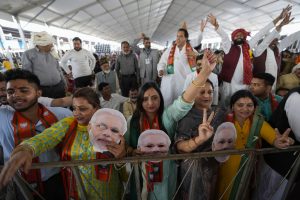On March 9, Sameer Ahmad Bhat, a sarpanch (head of a rural governance body or Panchayat) was assassinated in his home on the outskirts of Srinagar, the capital of the Union Territory of Jammu and Kashmir (J&K). Bhat had received a death threat last year. He had been told to confine himself to his house and not interact with outsiders.
Bhat is among several local elected leaders in J&K, who uphold the idea of Indian democracy and pay a price for that. They receive death threats from militants and often meet a fate similar to that of Bhat.
It is this idea of grassroot democracy that led to Bhat’s killing, and it is this idea which Modi endorsed in Jammu recently.
It has been more than two years since India’s ruling Bharatiya Janata Party (BJP) unilaterally stripped the then-state of J&K of its autonomous status guaranteed under the Indian Constitution’s Article 370. Prime Minister Narendra Modi’s recent visit to Palli in J&K’s Samba district was his first to J&K since that controversial decision.
Modi’s visit to Jammu focused on issues of development and decentralized grassroots democracy. During the visit he inaugurated several projects and pledged investment in infrastructure projects worth US$260 billion.
Just two days before Modi’s visit, militants carried out an attack at Sunjwan in Jammu. One policeman was killed and ten other police personnel were injured in the attack. J&K Police revealed that two militants, who were killed in the shoot-out that followed the attack, were affiliated with the Jaish-e-Mohammad, a Pakistan-based terror group.
Justifying his government’s decision to revoke J&K’s autonomy, the Modi government had said that it would bring stability and security to the region. However, there has been no improvement in the security situation since the abrogation of Article 370.
Attacks targeting civilians, members of the minority Hindu community and migrant workers have only increased since J&K was brought under New Delhi’s direct rule. The attack in Jammu just days before Modi’s arrival there signals the continuing uncertainty of the security situation in the region.
On the occasion of National Panchayat Day, which is celebrated to mark decentralization of power to local village bodies, Modi addressed the elected representatives of these bodies at Palli. “This year’s Panchayati Raj Day, being celebrated in J&K marks a big change,” he said. “It is a matter of great pride that when democracy has reached the grassroot level in J&K, I am interacting with you all from here.”
Incidentally, the Modi government held elections to panchayats (elected bodies in villages) in J&K two months after its special status was read down on August 5, 2019. Soon after J&K’s autonomy was revoked, the government set in motion a string of measures aimed at weakening J&K’s political parties. Dozens of politicians were detained, either held under house arrest or thrown in jail. This created a leadership vacuum in the Kashmir Valley and deepened political uncertainty there.
It was amid this situation that the Modi government held the panchayat elections. The grassroot leadership that Modi hailed was elected in the absence of three former chief ministers and other senior political leaders and activists of J&K.
Over 60 percent of the 19,582 seats in Kashmir went uncontested in Kashmir in the first election held in September 2019. Another round had to be held subsequently.
“Be it democracy or development, today Jammu and Kashmir, is setting a new example,” Modi claimed before his audience of local grassroots leaders.
The other focus of Modi’s visit was economic development. At 46 percent, J&K has the second highest unemployment rate in the country.
Modi inaugurated infrastructure projects during his visit. Among those who accompanied him on the visit were business leaders from the United Arab Emirates. Their presence alongside the Prime Minister signals the interest of industrialists and investors from a leading country of the Islamic block. Investors from UAE are expected to propose investments in the infrastructure sector amounting to over $400 million.
Modi’s visit to Samba district which borders Pakistan was aimed at showcasing not only grassroots democracy in J&K but also growing investment and infrastructural connectivity there.
However, such claims ring hollow as they lack substance since J&K does not have an elected government since 2018, a year before the erstwhile state’s special status was revoked by Modi’s Hindu nationalist government.
Elections may have been held to district and village councils in 2020 but local bodies do not have the power to legislate or amend laws in the region, which is being directly administered from New Delhi since 2018.
Modi’s sympathizers may believe that his trip to Jammu symbolizes the development achieved by his government in J&K. But this cannot mask the fact that alienation in J&K remains strong.
His speech in J&K was silent on elections. Over three years after direct rule from Delhi, the government has no clue about how to engage with the mainstream political parties in Kashmir. It is just as clueless about how it should move to undertake the restoration of J&K status as a state of India.

































